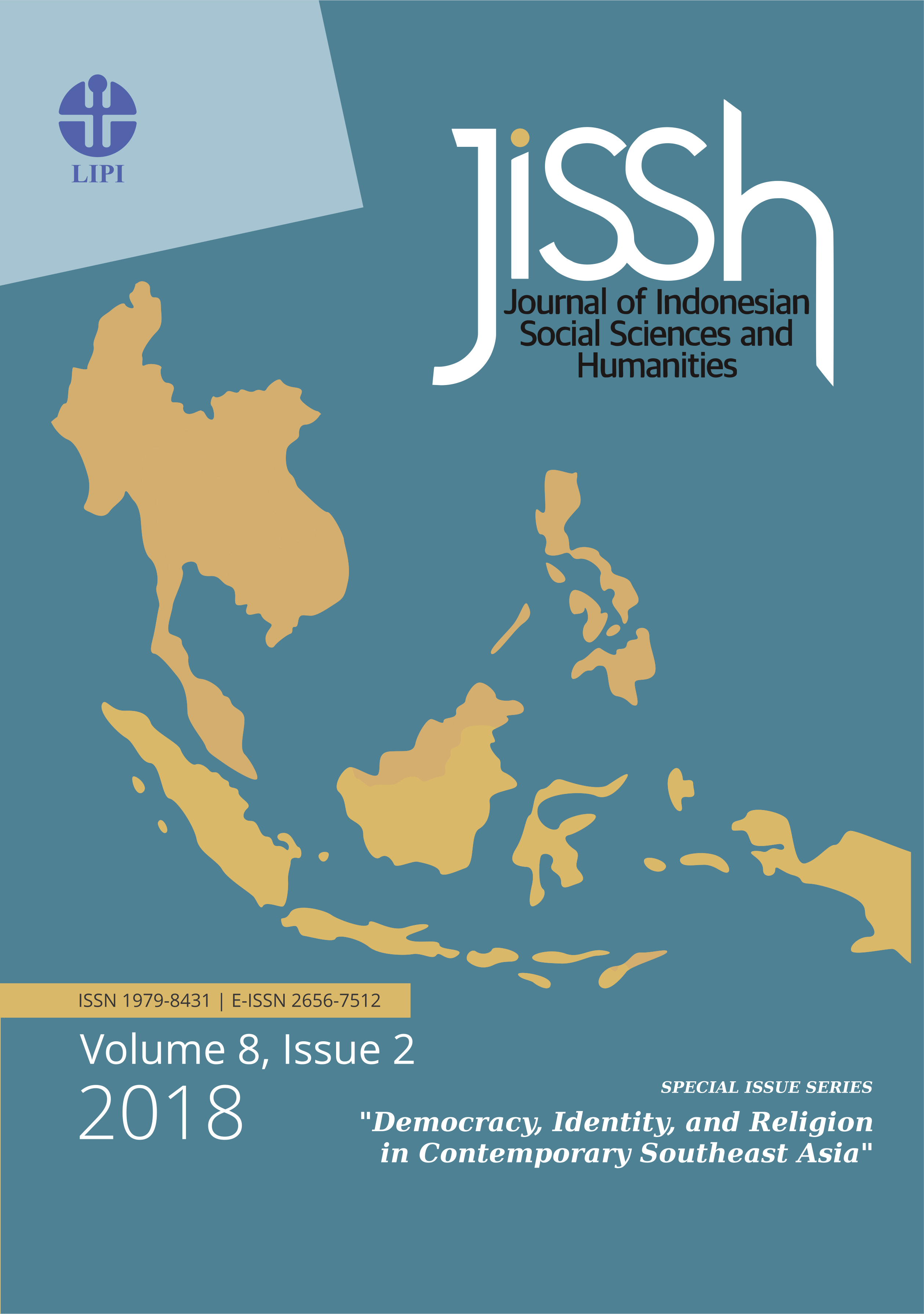The (Trans)Formation of Religious Capital in Indonesian Politics During New Order Era: A Case Study of Nahdlatul Ulama
Keywords:
de-politicization, Nahdlatul Ulama, new order, politics, religious capitalAbstract
Religious capital always has a crucial role in Indonesian politics. This paper aims to analyze the formation of religious capital in the New Order era that has been heavily influenced by the dynamics of the relationship between the state and religious groups, especially Islam, over time. As a case study, this paper will discuss Nahdlatul Ulama (NU). By analyzing the development of NU during the course of the New Order, it shows that the formation of religious capital was affected by the New Order’s systematic attempts to contain Islamic forces. Since the late 1960s until the midst of 1980s, the New Order orchestrated a systematic weakening of Islamic movement through destabilization and demonization of the Muslim community. It also attempted systematically to reduce the political power of Islamic elements by sanctioning several policies and regulations, especially simplification of the political party system in 1973 and the enforcement of Pancasila as the sole principle for socio-political life in 1985. In 1984 NU declared its resolution to return to its original status as religious-based social organization, adopted Pancasila as its principle, and formally retreated from politics. However, in the late 1980s and during 1990s, although institutionally experienced de-politicization, NU proved to remain significant in the political landscape. From this analysis, it is apparent that NU’s religious capital comprised of some ingredients: the centrality of ulama, the importance of securing NU community’s interests, and the necessity of resources obtained through a good relationship with the state.
References
Anam, Choirul. (1996). Gerak Langkah Pemuda Ansor:
Sebuah Percikan Sejarah Kelahiran. Jakarta:
Duta Aksara Mulia.
Barton, Greg. (2002). Gus Dur: The Authorized
Biography of Abdurrahman Wahid. Jakarta &
Singapore: Equinox Publishing.
Berger, Peter L., and Robert W. Hefner. (2003).
Spiritual capital in comparative perspective.
Paper prepared for the Spiritual Capital
Planning Meeting 2003.
Bertrand, Jacques. (2004). Nationalism and Ethnic
Conflict in Indonesia. Cambridge: Cambridge
University Press.
Bush, Robin. (2009). Nahdlatul Ulama and the
Struggle for Power within Islam and Politics in
Indonesia. Singapore: ISEAS.
Crouch, Harold. (1978). The Army and Politics in
Indonesia. Ithaca: Cornell University Press.
Fealy, Greg. (2009). Ijtihad Politik Ulama: Sejarah NU
1952–1967. Yogyakarta: LKiS.
Feillard, Andrée. (1995). NU vis-à-vis Negara: Pencar
ian Isi, Bentuk dan Makna. Yogyakarta: LKiS.
Gauntlett, D. (2018). Making is Connecting: The Social Meaning of Creativity, from DIY and Knitting to YouTube and Web 2.0. Malden: Polity Press.
Hadiz, Vedi R. (2011). Indonesian Political Islam: Capitalist Development and the Legacies of the Cold War. Journal of Current Southeast Asian Affairs 30(1), 3–38.
Iannaccone, Laurence R., and Klick, Jonathan. (2003). Spiritual capital: an introduction and literature review. Paper prepared for the Spiritual Capital Planning Meeting 2003.
Ismail, Faisal. (1995). Islam, Politics, and Ideology in Indonesia: A Study of the Process of Muslim Acceptance of the Pancasila. Dissertation, submitted to Institute of Islamic Studies, McGill University, Montreal.
Ketetapan MPR RI Nomor: IV/MPR/1978 tentang Garis-Garis Besar Haluan Negara.
Komisi Pemilihan Umum (KPU). (21 Februari 2008). Pemilu 1971. Retrieved from www. kpu.go.id/index.php/pages/detail/2018/9/ PEMILU-1971/MzQz. Accessed at 5 April 2018.
Komisi Pemilihan Umum (KPU). (21 Februari 2008). Pemilu 1977-1997. Retrieved from www.kpu.go.id/index.php/pages/detail/2017/10/ PEMILU-1971-1997/MzQz. Accessed at 5 April 2018.
Kusuma, Erwien. (2012). Yang Muda yang Berkiprah: Gerakan Pemuda Ansor dan Politik Indonesia Masa Demokrasi Liberal hingga Masa Reformasi (1950-2010). Bogor: Kekal Press.
McKinnon, A. M., Trzebiatowska, M., & Brittain, C. C. (2011). Bourdieu, capital, and conflict in a religious field: the case of the Anglican Communion. The Journal of Contemporary Religion 26(3), 355–370.
Mimbar Demokrasi. (1969). Mohammad Natsir Mengadjukan Tiga Saran untuk Tiga Pihak. Mimbar Demokrasi. No. 85, Tahun III, Minggu III, Mei.
Muqoddas, Busyro. (2011). Hegemoni Rejim Intelijen. Sisi Gelap Peradilan Kasus Komando Jihad. Yogyakarta: PUSHAM UII.
Natsir, Mohamad. (1969). Islam dan Kristen di Indonesia. Bandung: CV Bulan Sabit & CV Peladjar.
Pemberton, John. (1986). Notes on the 1982 General Election in Solo. Indonesia 41, 1–22.
Roosa, John. (2006). Pretext for Mass Murder: the September 30th Movement & Soeharto’s Coup d’Etat in Indonesia. Wisconsin: the University of Wisconsin Press.
Salim H. S., Hairus. (2004). Kelompok Paramiliter NU. Bantul: LKiS.
Sinar Harapan. (1967). Tidak Mungkin Pemilu Tahun 1968. Sinar Harapan. August 4.
Sitompul, E. M. (1989). NU dan Pancasila: Sejarah dan Peranan NU dalam Perjuangan Umat Islam di Indonesia dalam rangka Penerimaan Pancasila sebagai Satu-Satunya Asas. Jakarta: Pustaka Sinar Harapan.
Solahudin. (2011). NII sampai JI, Salafy Jihadisme di Indonesia. Depok: Komunitas Bambu.
Team Dokumentasi Presiden RI. (1991). Jejak Langkah Pak Harto: 28 Maret 1968-23 Maret 1973. Jakarta: PT Citra Lamtoro Gung Persada.
Ufen, Andreas. (2008). From Aliran to Dealignment: Political Parties in Post-Soeharto Indonesia. South East Asia Research 16(1), 5–41.
Van Bruinessen, Martin. (1994). NU: Tradisi, Relasi-Relasi Kuasa, Pencarian Wacana Baru. Yogyakarta: LKiS.
Van Bruinessen, Martin. (2002). Genealogies of Islamic Radicalism in Post-Soeharto Indonesia. South East Asia Research 10(2), 117–154
Downloads
Published
Issue
Section
License

This work is licensed under a Creative Commons Attribution-ShareAlike 4.0 International License.
Authors who publish with this journal agree to the following terms:
1. Authors retain copyright and grant the journal right of first publication with the work simultaneously licensed under an Attribution-ShareAlike 4.0 International (CC BY-SA 4.0) license. This license allows others to remix, adapt, and build upon the work, as long as they credit the author and license their new creations under the same terms.
2. Authors may enter into separate, additional contractual arrangements for the non-exclusive distribution of the journal’s published version of the work (e.g., posting it to an institutional repository or including it in a book), provided there is an acknowledgment of its initial publication in this journal.
3. Authors are permitted and encouraged to post their work online (e.g., in institutional repositories or on their personal website) prior to and during the submission process, as this can lead to productive exchanges and increase citations of the published work (See The Effect of Open Access ).


















